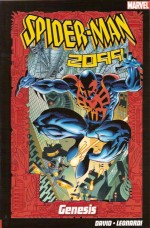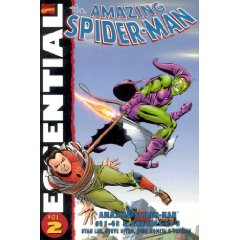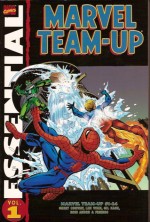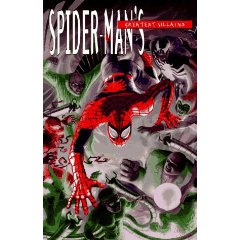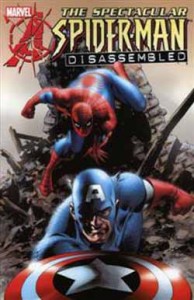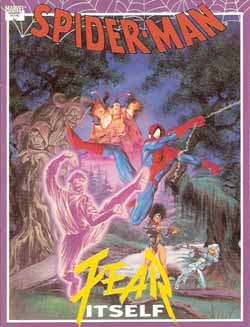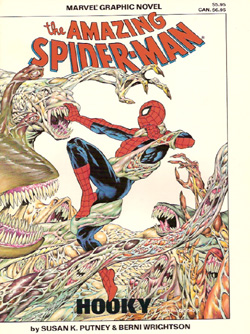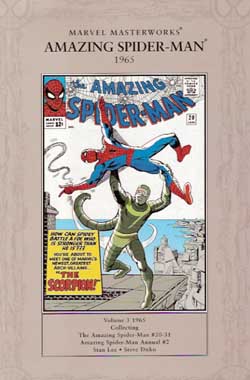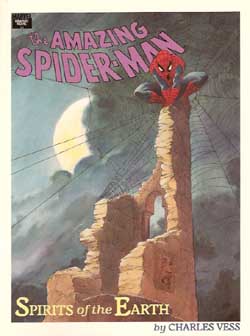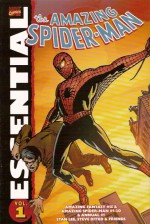
By Stan Lee & Steve Ditko (Marvel)
ISBN: 978-0-7851-2192-3
Marvel is often termed “the House that Jack Built” and King Kirby’s contributions are undeniable and inescapable in the creation of a new kind of comic book story-telling, but there was another unique visionary at Atlas-Comics-as-was; one whose creativity and even philosophy seemed diametrically opposed to the bludgeoning power, vast imaginative scope and clean, broad lines of Kirby’s ever-expanding search for gods and the infinite.
Steve Ditko was quiet and unassuming, voluntarily diffident to the point of invisibility though his work was both subtle and striking: innovative, meticulously polished, always questing for detail he ever explored the man within. He found heroism – and humour and ultimate evil – all contained within the frail but noble confines of human scope and consciousness. His drawing could be oddly disquieting… and, when he wanted, almost creepy.
Drawing monster and mystery tales for Stan Lee, Ditko had been given his own title. Amazing Adventures/Amazing Adult Fantasy featured a subtler brand of yarn than Furry Underpants Monsters, invading aliens and the ilk which, though individually entertaining, were slowly losing traction in the world of comics since National/DC had reintroduced costumed heroes. Lee and Kirby had responded with Fantastic Four (and the ahead-of-its-time Incredible Hulk) but there was no indication of the renaissance to come when Amazing Fantasy #15 (the last issue) cover featured a brand new adventure character: Spider-Man.
In 11 captivating pages ‘Spider-Man!’ told the parable of Peter Parker, a smart but aloof High School kid who was bitten by a radioactive spider. Discovering his body had developed arachnid abilities which he augmented with his own natural engineering genius, he did what any lonely, geeky nerd would do when given such a gift – he tried to cash in for girls, fame and money.
Making a costume to hide his identity secret in case he made a fool of himself, Parker/ Spider-Man became a minor celebrity – and a self-important one. To his eternal regret, when a thief fled past he didn’t lift a finger to stop him, only to find a burglar had murdered his uncle Ben when he returned home.
Crazy for revenge Parker hunted the thief who had made his beloved Aunt May a widow and killed the only father he had ever known, only to find that it was the felon he couldn’t be bothered with. His social irresponsibility had led to the death of the man who raised him and the boy swore to use his powers to help others…
It wasn’t a new story, but the setting was one familiar to every kid reading it and the artwork was downright spooky. This wasn’t the gleaming high-tech world of moon-rockets, giant monsters and flying cars- this stuff could happen to anybody… Amazing Fantasy #15 came out the same month as Tales to Astonish #35 (cover-dated September 1962) which was the first to feature the Astonishing Ant-Man in costumed capers, but it was the last issue of Ditko’s Amazing playground.
However the tragic last-ditch tale had struck a chord with the reading public and by Christmas a new comicbook superstar was ready to launch in his own title, with Ditko eager to show what he could do with his first returning character since the demise of the Charlton hero Captain Atom (see Action Heroes Archive volume 1, ISBN 1-4012-0302-7). Holding on to the “Amazing” prefix to help jog reader’s memories, the bi-monthly Amazing Spider-Man #1 had a March cover-date and two stories. It prominently featured the Fantastic Four and took the readers by storm. The first tale, again simply entitled ‘Spider-Man!’ recapitulated the origin whilst adding a brilliant twist to the conventional mix.
The wall-crawling hero was feared and reviled by the general public thanks in no small part to J. Jonah Jameson, a newspaper magnate who pilloried the adventurer from spite and for profit. With typical comic book irony, Spider-Man then had to save Jameson’s astronaut son John from a faulty space capsule… The second story ‘Vs the Chameleon!’ found the cash-strapped kid trying to force his way onto the roster of the Fantastic Four whilst a spy impersonated the web-spinner to steal military secrets, in a perfect example of the high-strung, antagonistic crossovers and cameos that so startled the jaded kids of 1963. Heroes just didn’t act like that…
With the second issue our new kind of hero began a meteoric rise in quality and innovative storytelling. ‘Duel to the Death with the Vulture!’ found Peter Parker chasing after a flying thief as much for profit as justice. Desperate to help his widowed Aunt make ends meet, the hero began to take photos of his cases to sell to Jameson’s Daily Bugle, making his personal gadfly his sole means of support. Along with comedy and soap-operatic melodrama Ditko’s action sequences were imaginative and magnificently visceral, with odd angle shots and quirky, mis-balanced poses adding a vertiginous sense of unease to the fight scenes. But crime wasn’t the only threat to the world and Spider-Man was just as (un)comfortable battling science-fictional menaces like ‘The Uncanny Threat of the Terrible Tinkerer!’
Amazing Spider-Man #3 introduced one of the young hero’s greatest enemies in ‘Versus Doctor Octopus’, a full-length epic wherein a dedicated scientist survived an atomic accident which grafted mechanical tentacles to his body. Power-mad, Otto Octavius even thrashed Spider-Man, sending the lad into a depression until an impromptu pep-talk from the Human Torch galvanized Spider-Man to one of his greatest victories.
‘Nothing Can Stop… the Sandman!’ was another instant classic as a common thug gained the power to transform to sand (another pesky nuclear cock-up) and invaded Parker’s school, whilst issue #5 found the web-spinner ‘Marked for Destruction by Dr. Doom!’ and not so much winning as surviving his battle against the deadliest man on Earth. Presumably he didn’t mind too much as this marked the transition from bi-monthly to monthly status for the series.
Sometime mentor Curtis Connors debuted in #6 when Spidey came ‘Face-to-face with… The Lizard!’ as the hero fought his battle away from the concrete canyons of New York – specifically in the murky Florida Everglades, but he was back in the Big Apple in #7 to tackle ‘The Return of the Vulture’. Fun and youthful hi-jinks were a signature feature of the series, as was Parker’s budding romance with “older woman” Betty Brant.
She was Jameson’s secretary at the Bugle and youthful exuberance was the underlying drive in #8’s lead tale ‘The Living Brain!’ a robot calculator that threatened to expose Spider-Man’s secret identity before running amok at beleaguered Midtown High, just as Parker was finally beating the stuffings out of school bully Flash Thompson. This 17 page joy was accompanied by ‘Spiderman Tackles the Torch!’ (a 6 page vignette drawn by Jack Kirby and inked by Ditko) wherein a boisterous wall-crawler gate-crashed a beach part thrown by the flaming hero’s girlfriend with explosive consequences.
Amazing Spider-Man #9 was a qualitative step-up in dramatic terms as Aunt May was revealed to be chronically ill – adding to Parker’s financial woes – and the action was supplied by ‘The Man Called Electro!’ a super-criminal with grand aspirations. Spider-Man was always a loner, never far from the streets and small-scale-crime, and with this tale wherein he also quells a prison riot single handed, Ditko’s preference for tales of gangersterism began to show through; a predilection confirmed in #10’s ‘The Enforcers!’ a classy mystery where a masked mastermind known as the Big Man used a position of trust at the Bugle to organize all the New York mobs into one unbeatable army against decency. Longer plot-strands are also introduced as Betty Brant disappears, but most fans remember this one for the spectacularly climactic seven-page fight scene in an underworld chop-shop that has still never been topped for action-choreography.
‘Turning Point’ and ‘Unmasked by Dr. Octopus!’ saw the return of the deadly scientist and the revelation of Betty’s dark secret in a tragedy-filled tale of extortion and non-stop that stretched from Philadelphia to the Bronx Zoo and again tempered the melodrama with spectacular fight scenes in unusual and exotic locations.
A new super-foe premiered in #13 with ‘The Menace of Mysterio!’ hired by Jameson to capture Spider-Man but with his own dark agenda, whilst the next issue was a true landmark as a criminal mastermind manipulated a Hollywood studio into making a movie about the wall-crawler. With guest-stars the Enforcers and the Incredible Hulk ‘The Grotesque Adventure of the Green Goblin’ is most notable for introducing Spider-Man’s most perfidious and flamboyant enemy.
Jungle superman and thrill-junkie ‘Kraven the Hunter!’ made Spider-Man his intended prey at the behest of the Chameleon in #15, whilst the Ringmaster and his Circus of Evil prompted #16’s dazzling ‘Duel with Daredevil’ but separating those two classics here are the varied and captivating contents of Amazing Spider-Man Annual #1 (Summer 1964), starting with a 41 page epic peppered with guest-stars from the burgeoning Marvel Universe as the Web-Spinner battled Doctor Octopus, Kraven, Sandman, Mysterio, Electro and the Vulture, collectively known as ‘The Sinister Six!‘ This bombastic clash was augmented by a pin-up gallery of Famous Foes, fact-features ‘The Secrets of Spider-Man’, ‘Spidey’s Super Senses’, ‘Secrets of Spider-Man’s Mask’, a selection of posters and the legendary comedy short ‘How Stan Lee and Steve Ditko Create Spider-Man!’
An ambitious three-part saga began in Amazing Spider-Man #17, which saw the hero touch emotional bottom before rising to triumphant victory over all manner of enemies. ‘The Return of the Green Goblin!’ saw the hero endure renewed print assaults from the Daily Bugle as the Goblin began a war of nerves using the Enforcers, Sandman and a host of thugs to publicly humiliate the hero, just as Aunt May’s health took a drastic downward turn.
Continued in ‘The End of Spider-Man!’ and concluded in ‘Spidey Strikes Back!’ featuring a telling team-up with friendly rival the Human Torch, this extended tale proved that the fans were ready for every kind of narrative experiment (single issue and even two stories per issue were still the norm in 1964) and Stan and Steve were prepared to try it.
The book closes with ‘The Coming of the Scorpion!’ wherein Jameson let his obsessive hatred for the arachnid hero get the better of him, hiring scientist Farley Stillwell to give a private detective Scorpion-based superpowers. Unfortunately the process drove the subject mad before he could capture Spidey, leaving the wall-crawler with yet another super-nutcase to deal with…
Such was the life of comic’s most misunderstood hero and this gloriously economical collection is especially welcome because of a secret I can now reveal:
Colour printing has never really been Steve Ditko’s friend.
His wealth of line variety, his blend of moody blacks and nuanced shading as well as his simplified, almost “big-foot” style of design and drawing is most powerful as dark against light – Black on White. These landmark tales still resonate with power and creativity and they’re at their very best without the pretty tints and hues – although don’t let me stop you from buying other versions of these oft-reprinted gems – just read this book first!
© 1962, 1963, 1964, 1965, 2006 Marvel Characters, Inc. All Rights Reserved.
